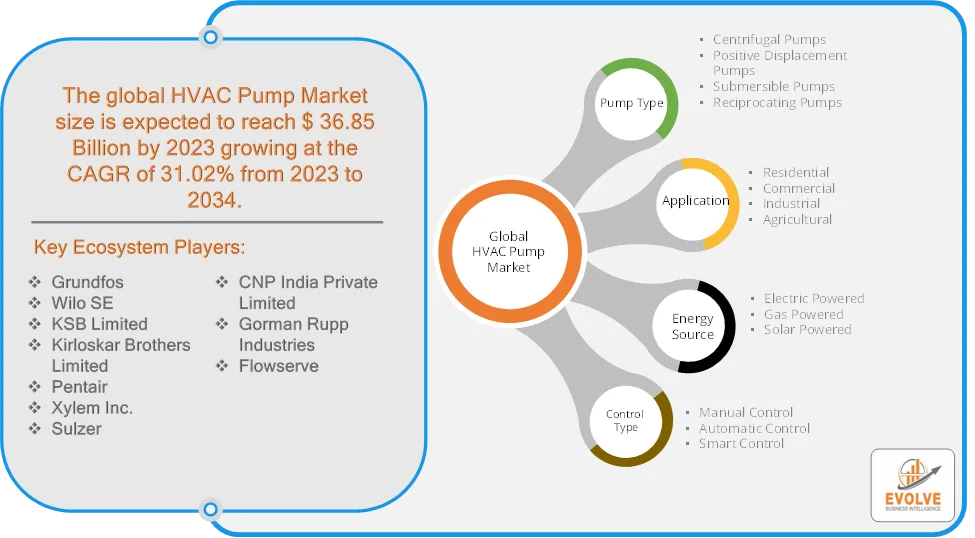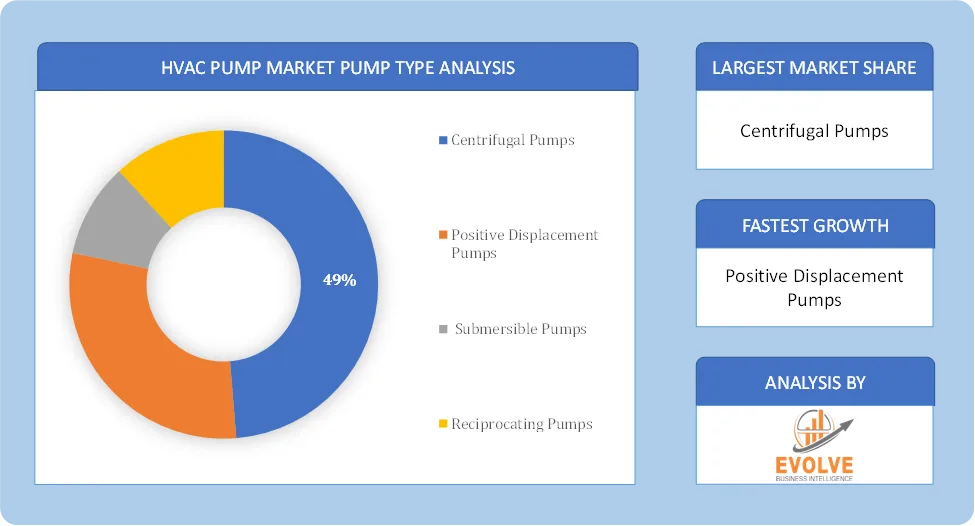Global HVAC Pump Market Forecast to Reach USD 45.88 Billion by 2034, Growing at a 31.02% CAGR

Evolve Business Intelligence has published a research report on the Global HVAC Pump Market, 2024–2034. The global HVAC Pump Market is projected to exhibit a CAGR of around 31.02% during the forecast period of 2024 to 2034.
Evolve Business Intelligence has recognized the following companies as the key players in the global HVAC Pump Market: Grundfos, Wilo SE, KSB Limited, Kirloskar Brothers Limited, Pentair, Xylem Inc., Sulzer, CNP India Private Limited, Gorman Rupp Industries and Flowserve.
The Global HVAC Pump Market is projected to be valued at USD 45.88 Billion by 2034, recording a CAGR of around 31.02% during the forecast period. The HVAC (Heating, Ventilation, and Air Conditioning) Pump Market is a crucial segment of the HVAC industry, providing essential pumping solutions for heating and cooling applications across residential, commercial, and industrial sectors. These pumps help circulate water, refrigerants, and other fluids through HVAC systems to maintain optimal indoor temperature and air quality.
The HVAC pump market is experiencing robust growth driven by the increasing demand for energy-efficient solutions, urbanization, industrialization, and technological advancements. The trend towards smart and variable-speed pumps, along with a growing emphasis on sustainability.
Download the full report now to discover market trends, opportunities, and strategies for success.
Segmental Analysis
The global HVAC Pump Market has been segmented based on Pump Type, Application, Energy Source and Control Type.
Based on Pump Type, the HVAC Pump Market is segmented into Centrifugal Pumps, Positive Displacement Pumps, Submersible Pumps, Reciprocating Pumps. The Reciprocating Pumps segment is anticipated to dominate the market.
Based on Application, the global HVAC Pump Market has been divided Residential, Commercial, Industrial, Agricultural. The Residential segment is anticipated to dominate the market.
Based on Energy Source, the global HVAC Pump Market has been divided into Electric Powered, Gas Powered, Solar Powered. The Electric Powered segment is anticipated to dominate the market.
Based on Control Type, the global HVAC Pump Market has been divided into Manual Control, Automatic Control, Smart Control. The Smart Control segment is anticipated to dominate the market.
Regional Analysis
The HVAC Pump Market is divided into five regions: North America, Europe, Asia-Pacific, South America, and the Middle East, & Africa. In North America, The United States and Canada lead the market due to high demand for energy-efficient HVAC systems in residential, commercial, and industrial buildings. Growth in data centers and smart buildings further supports the demand for high-performance HVAC pumps. Rising adoption of IoT-enabled and smart HVAC solutions and expansion of green buildings and LEED-certified projects. The European Union (EU) emphasizes carbon neutrality and sustainability, driving demand for eco-friendly HVAC pumps. Countries like Germany, France, the UK, and the Nordic nations are investing heavily in district heating and cooling systems, increasing demand for high-efficiency pumps. Asia-Pacific region is fastest-growing region, driven by rapid urbanization, industrialization, and construction in China, India, Japan, and Southeast Asia. Massive demand for residential and commercial HVAC systems due to extreme climate conditions and rising disposable income and smart cities and infrastructure projects in India and China are boosting the adoption of energy-efficient HVAC pumps. Extreme temperatures in the Middle East drive high demand for HVAC cooling solutions, especially in countries like Saudi Arabia, UAE, and Qatar and Large-scale commercial and hospitality projects, including airports, shopping malls, and hotels, increase the need for high-performance HVAC pumps. In Latin America region, the market is growing in Brazil, Mexico, Argentina, and Chile, driven by industrial expansion and commercial construction. Government initiatives to promote energy efficiency are increasing HVAC pump adoption in commercial and residential sectors and the growing middle-class population and urbanization contribute to higher HVAC system installations.



